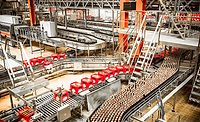Digitalization
Finding a digital strategy to manage electrical consumption at sugar plants
Not only do sugar plants consume a huge amount of power, their carbon footprint is generally not so enviable

No question about it, sugar plants consume vast amounts of electricity, and with a lot of aging equipment, there’s no doubt that several motors and the mechanical systems they drive are probably consuming more power than they should—due to worn bearings and a general lack of maintenance. In many instances, motors are probably not using variable speed drives, and large inrush currents place a big demand on electrical utilities.
Unfortunately, in many facilities, managers have grown accustomed to high energy usage and carbon emission levels. But today, it’s becoming easier to install sensors to monitor motor currents and vibration due to worn bearings. With digitalization, it’s easier to “pick the low-hanging fruit” and get some big returns.
ABB has a lot of experience worldwide with helping food and beverage plants manage their utilities, equipment and energy usage. We asked Robert Glass, ABB’s global food and beverage manager to describe the situation in sugar plants.
FE: So what’s the issue—why can’t sugar plants get control of their energy usage?
Glass: There’s a famous management mantra that goes, “what gets measured gets managed.” While the source of this quote is subject to debate, the sentiment behind it isn’t: you can only effectively manage and improve things that you have sufficient data about. Without insight, you can’t act or make an informed decision.
This has never been truer than in modern times, as food and beverage businesses increasingly realize the value and benefits of digitalization. Likewise, few facilities are as primed to benefit from it as sugar production and processing plants, where navigating the energy-intensive processes to identify areas for improvement can be challenging without insight.
FE: How much power do sugar mills typically use?
Glass: Sugar mills generally demand considerable amounts of electricity to run smoothly due to the intensive process of refining sugar. From ABB’s experience in the sugar industry, using 45–50GWh of electricity every year is nothing unusual for a typical sugar cane plant. But when you consider that this could power approximately 12,000 households across Europe, the scope of the problem becomes apparent.
FE: What about the impact on climate?
Glass: It becomes even more concerning when you consider this alongside reports from the Tyndall Centre for Climate Change Research in the UK, which projected that 2017 would see carbon emissions reach a record high after years of stability. The official figures have yet to be confirmed, but an increase could form the basis of tighter emissions rules across UN countries, given the importance of the 2015 Paris climate agreement.
With that in mind, energy efficiency for sugar plant managers is as much about establishing a competitive advantage as it is reducing expenses. In order to improve efficiency, managers must understand what is causing their plant to consume so much power.
FE: How do you get at the root causes of power consumption in a sugar plant?
Glass: Often, ABB’s engineers will conduct a plant assessment and find that inefficient electrical equipment is the cause of the excessive power consumption. This could mean modernizing an electric motor or installing high efficiency drives could be the solution, but there is no one size fits all approach to managing a sugar plant. So, how can you determine where your plant’s specific inefficiencies lie?
As the management mantra suggests, monitoring and measuring operational data will give a strong indication of what is causing high energy usage. However, this has traditionally been a long-winded and time-consuming process of manually retrieving and compiling data before analyzing it.
FE: Isn’t there a better way to get a handle on the energy usage in the plant?
Glass: Fortunately, that’s where the digitalization of sugar plants helps managers take control of processes. By using equipment and sensors designed with connectivity in mind, sugar plant managers and engineers can automate the data collection process. But this data must then be collected into a central operational management system, such as the ABB Ability manufacturing operations management (MOM) system.
FE: How does the use of a MOM system benefit the plant?
Glass: Using ABB’s MOM system, sugar plant managers have an extensive overview of the performance of their plant’s operations. The MOM system features an energy monitor app that allows managers to analyze not only current levels of energy usage and emissions, but to also compare it against historic data. Managers can use this to see, in near real-time, changes in usage to determine if anything out of the ordinary has happened with any equipment, such as if it has an elevated electrical draw that may indicate maintenance is required.
ABB has also drawn from its extensive experience in the sugar industry to develop its sugar application library, which provides engineers with a comprehensive databank of all sugar production processes. Engineers can use this to control variables in processes across the factory, as well as benchmark energy costs.
With these systems offering greater transparency of energy usage throughout the plant, managers can act accordingly to reduce costs and emissions. In the age of digitalization, monitoring operational data isn’t just a precursor to better management, it’s also a forerunner to better operational efficiency and lower operational expense.
For more information on ABB’s MOM system, visit the ABB Website.
Looking for a reprint of this article?
From high-res PDFs to custom plaques, order your copy today!








